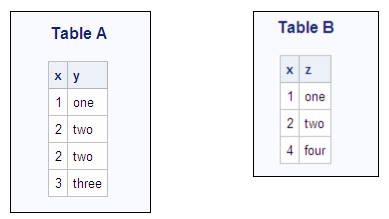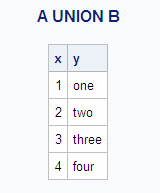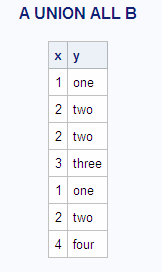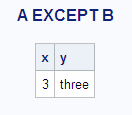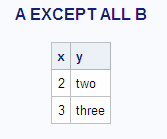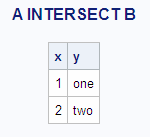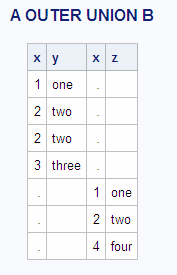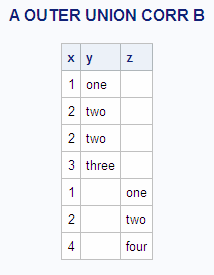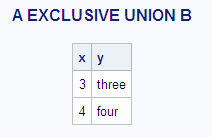Combining Queries with Set Operators
Working with Two or More Query Results
PROC SQL can combine
the results of two or more queries in various ways by using the following
set operators:
The operator is used
between the two queries, for example:
select columns from table
set-operator
select columns from table; Place a semicolon after
the last SELECT statement only. Set operators combine columns from
two queries based on their position in the referenced tables without
regard to the individual column names. Columns in the same relative
position in the two queries must have the same data types. The column
names of the tables in the first query become the column names of
the output table. For information about using set operators with more
than two query results, see the SQL Procedure. The following optional keywords give
you more control over set operations:
Producing Unique Rows from Both Queries (UNION)
Producing Rows That Are in Only the First Query Result (EXCEPT)
The EXCEPT operator returns rows
that result from the first query but not from the second query. In
this example, the row that contains the values
3 and three exists in the first query (table
A) only and is returned by EXCEPT.
Concatenating Query Results (OUTER UNION)
Producing Rows from the First Query or the Second Query
There is no keyword
in PROC SQL that returns unique rows from the first and second table,
but not rows that occur in both. Here is one way that you can simulate
this operation:
proc sql;
title 'A EXCLUSIVE UNION B';
(select * from sql.a
except
select * from sql.b)
union
(select * from sql.b
except
select * from sql.a);The first EXCEPT returns
one unique row from the first table (table A) only. The second EXCEPT
returns one unique row from the second table (table B) only. The middle
UNION combines the two results. Thus, this query returns the row from
the first table that is not in the second table, as well as the row
from the second table that is not in the first table.
Copyright © SAS Institute Inc. All rights reserved.
